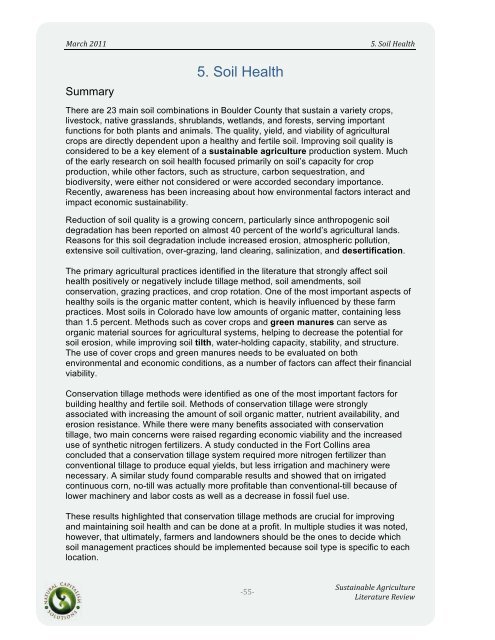Sustainable Agriculture Literature Review - Boulder County
Sustainable Agriculture Literature Review - Boulder County
Sustainable Agriculture Literature Review - Boulder County
You also want an ePaper? Increase the reach of your titles
YUMPU automatically turns print PDFs into web optimized ePapers that Google loves.
! !!<br />
"#$%&!'())!! !!!!!!!!!!!!!!!!!!!!!!!!!!!!!!!!!!!!!!!!!!!!!!!!!!!!!!!!!!!!!!!!!!!!!!!!!E=!*D.1!F2#1-&!<br />
Summary<br />
!<br />
5. Soil Health<br />
There are 23 main soil combinations in <strong>Boulder</strong> <strong>County</strong> that sustain a variety crops,<br />
livestock, native grasslands, shrublands, wetlands, and forests, serving important<br />
functions for both plants and animals. The quality, yield, and viability of agricultural<br />
crops are directly dependent upon a healthy and fertile soil. Improving soil quality is<br />
considered to be a key element of a sustainable agriculture production system. Much<br />
of the early research on soil health focused primarily on soil’s capacity for crop<br />
production, while other factors, such as structure, carbon sequestration, and<br />
biodiversity, were either not considered or were accorded secondary importance.<br />
Recently, awareness has been increasing about how environmental factors interact and<br />
impact economic sustainability.<br />
Reduction of soil quality is a growing concern, particularly since anthropogenic soil<br />
degradation has been reported on almost 40 percent of the world’s agricultural lands.<br />
Reasons for this soil degradation include increased erosion, atmospheric pollution,<br />
extensive soil cultivation, over-grazing, land clearing, salinization, and desertification.<br />
The primary agricultural practices identified in the literature that strongly affect soil<br />
health positively or negatively include tillage method, soil amendments, soil<br />
conservation, grazing practices, and crop rotation. One of the most important aspects of<br />
healthy soils is the organic matter content, which is heavily influenced by these farm<br />
practices. Most soils in Colorado have low amounts of organic matter, containing less<br />
than 1.5 percent. Methods such as cover crops and green manures can serve as<br />
organic material sources for agricultural systems, helping to decrease the potential for<br />
soil erosion, while improving soil tilth, water-holding capacity, stability, and structure.<br />
The use of cover crops and green manures needs to be evaluated on both<br />
environmental and economic conditions, as a number of factors can affect their financial<br />
viability.<br />
Conservation tillage methods were identified as one of the most important factors for<br />
building healthy and fertile soil. Methods of conservation tillage were strongly<br />
associated with increasing the amount of soil organic matter, nutrient availability, and<br />
erosion resistance. While there were many benefits associated with conservation<br />
tillage, two main concerns were raised regarding economic viability and the increased<br />
use of synthetic nitrogen fertilizers. A study conducted in the Fort Collins area<br />
concluded that a conservation tillage system required more nitrogen fertilizer than<br />
conventional tillage to produce equal yields, but less irrigation and machinery were<br />
necessary. A similar study found comparable results and showed that on irrigated<br />
continuous corn, no-till was actually more profitable than conventional-till because of<br />
lower machinery and labor costs as well as a decrease in fossil fuel use.<br />
These results highlighted that conservation tillage methods are crucial for improving<br />
and maintaining soil health and can be done at a profit. In multiple studies it was noted,<br />
however, that ultimately, farmers and landowners should be the ones to decide which<br />
soil management practices should be implemented because soil type is specific to each<br />
location.<br />
"&&"<br />
!*+,-#./#012!34$.%+1-+$2!<br />
5.-2$#-+$2!627.28!
















